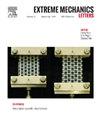基于隐式几何描述符的人工神经网络框架用于构建纳米纤维材料的统一结构-性能关系
IF 4.5
3区 工程技术
Q2 MATERIALS SCIENCE, MULTIDISCIPLINARY
引用次数: 0
摘要
分层结构的纳米纤维材料,如垂直排列的碳纳米管(VACNT)泡沫,从纳米尺度尺寸效应和结构内部和结构之间的纳米管相互作用的相互作用中获得了卓越的机械性能。然而,这些被结构放大的机制对不同机械性能的不同影响仍然难以捉摸,限制了它们对目标性能组合的独立可调性。依赖于特定于体系结构的显式设计参数进一步抑制了植根于这些纳米级机制的统一结构-性能关系的发展。本文在人工神经网络(ANN)框架中引入了两个隐式几何描述符——多分量形状不变量(MCSI),以建立统一的结构-属性关系来管理不同的体系结构。mcsi有效地捕获了产生体力学性能(如比能吸收、峰值应力和平均模量)的关键纳米尺度机制。利用其预测设计机械性能的能力,甚至在训练数据之外,我们提出了通用的设计策略,以实现在体系结构VACNT泡沫中所需的机械性能组合。这种隐式描述符支持的人工神经网络框架可以指导复杂分层材料的加速和易于处理的设计,应用范围从极端环境中的减震层到软机器人中的功能组件。本文章由计算机程序翻译,如有差异,请以英文原文为准。

Implicit geometric descriptor-enabled ANN Framework for a unified structure-property relationship in architected nanofibrous materials
Hierarchically architected nanofibrous materials, such as the vertically aligned carbon nanotube (VACNT) foams, draw their exceptional mechanical properties from the interplay of nanoscale size effects and inter-nanotube interactions within and across architectures. However, the distinct effects of these mechanisms, amplified by the architecture, on different mechanical properties remain elusive, limiting their independent tunability for targeted property combinations. Reliance on architecture-specific explicit design parameters further inhibits the development of a unified structure–property relationship rooted in those nanoscale mechanisms. Here, we introduce two implicit geometric descriptors — multi-component shape invariants (MCSI) — in an artificial neural network (ANN) framework to establish a unified structure–property relationship that governs diverse architectures. The MCSIs effectively capture the key nanoscale mechanisms that give rise to the bulk mechanical properties such as specific-energy absorption, peak stress, and average modulus. Exploiting their ability to predict mechanical properties for designs that are even outside of the training data, we propose generalized design strategies to achieve desired mechanical property combinations in architected VACNT foams. Such implicit descriptor-enabled ANN frameworks can guide the accelerated and tractable design of complex hierarchical materials for applications ranging from shock-absorbing layers in extreme environments to functional components in soft robotics.
求助全文
通过发布文献求助,成功后即可免费获取论文全文。
去求助
来源期刊

Extreme Mechanics Letters
Engineering-Mechanics of Materials
CiteScore
9.20
自引率
4.30%
发文量
179
审稿时长
45 days
期刊介绍:
Extreme Mechanics Letters (EML) enables rapid communication of research that highlights the role of mechanics in multi-disciplinary areas across materials science, physics, chemistry, biology, medicine and engineering. Emphasis is on the impact, depth and originality of new concepts, methods and observations at the forefront of applied sciences.
 求助内容:
求助内容: 应助结果提醒方式:
应助结果提醒方式:


